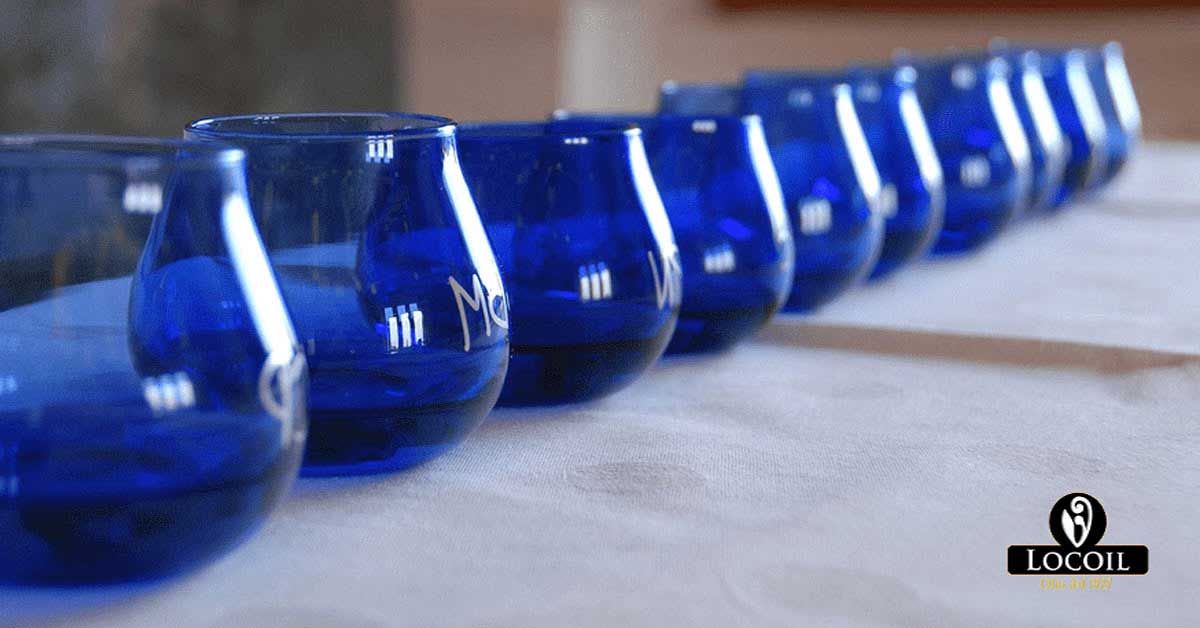OIL TASTING – PANEL TEST GUIDE

PANEL TEST: LET’S FIND OUT WHEN THE OIL IS GOOD
The modern consumer of extra virgin olive oil, from studies conducted, has few cognitive tools that allow him or her to objectively evaluate the oil, through the panel test it is possible to identify the quality of the oil.
The basic elements for evaluating the organoleptic quality of oil are:
COLOR
Freshly obtained oil at the mill is green in color.
For good storage it should be corked and kept at low temperatures, in the dark and can be consumed immediately, otherwise it should be decanted.
ODOR – THE SCENT-AROMA
The ‘sense of smell is the most important sense for oil evaluation.
The volatile substances characteristic of extra virgin oils are derived directly from the fruit, giving the oil a typical, defined aroma:
“Fruity Of Olive.”
On tasting, a green fruitiness can be distinguished from a ripe fruitiness:
- green fruitiness is characteristic of oil obtained from green, unripe olives;
- ripe fruitiness is characteristic of oil obtained from ripe olives, less pungent and, generally, of mild aroma and sweetish taste.
TASTE
The antioxidant substances in the olive give the oil a typical bitter-peppery taste that is a real asset of the product.
Many, unfortunately, mistake this virtue for a flaw by deeming it “sour”
QUALITY OF EXTRA VIRGIN OIL
The main components of extra virgin oil are:
- ANTIOXIDANT
- ANTI-INFLAMMATORY
- HYPOTHESIS
Extra virgin oil is the only one that does not undergo refining treatments so it is the only one that contains sufficient elements to make oil a true natural medicine.
The oil provides excellent health benefits, can also be used as a cosmetic ( put it on hands and let it absorb slowly, it leaves no unpleasant odor or greasiness, compared to a cream it is slower to absorb). It leaves the skin soft and fresh ideal for the face and body.
It’s great to drink a small amount every day since extra virgin oil contains beneficial substances with antitumor, anticholesterol, anti-arthritic, digestive, antithrombotic,neuroprotective action, a real panacea.
RAVECE OIL CHARACTERISTICS
- Smelling it, we smell an intense fruity, green type (grass), with hints of tomato, almond and artichoke.
Intense bitter and spicy notes on the palate;
Herbaceous, tomato and artichoke aftertaste.
Green color with yellow highlights; intense fluidity.
- Tasting it gives a bitter and spicy sensation at the base of the tongue, a sensation due to the presence of natural antioxidants that protect the oil during storage and cooking.
HOW TO TASTE EXTRA VIRGIN OLIVE OIL.
Approaching the technique of oil tasting is important both for olive growers for the quality of the product but it is also important for all consumers and cooks for a more informed choice of oil to put on the table, so here is how to go about panel testing.
Step 1: Pour a tablespoon of oil into a small glass;
Step 2: Cover it and warm it in the palm of your hand to facilitate odor perception.
An initial assessment is made by bringing the glass close to the nose and inspiring 2o3 times in a row focusing on the smell.
At this point take a small sip of oil, distributing it throughout the mouth by taking in air with short aspirations.
In this way, the olfactory and gustatory perceptions of bitter-tasting are defined.

Alfio Lo Conte
Tecnico ed esperto degli oli extravergini di oliva, iscritto nell’Elenco Nazionale sezione Campania.
Maestro di frantoio con diploma, conseguito presso International Extravirgin Agency.
Read more articles by: Alfio Lo Conte
Recent Comments